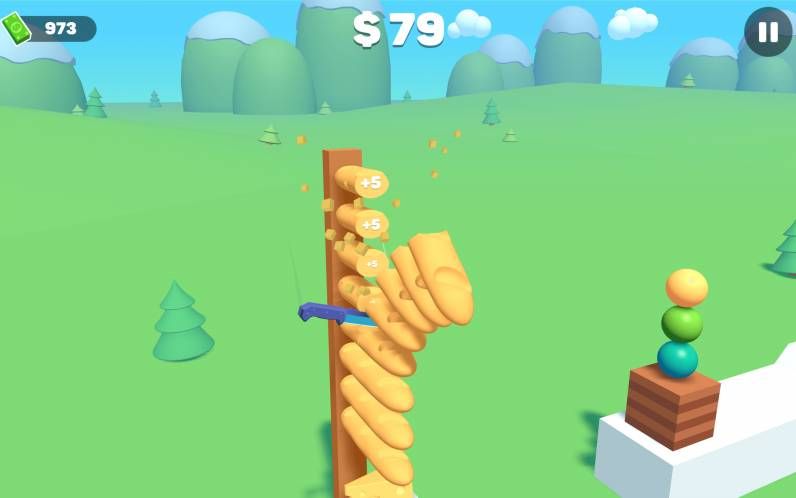

Welcome to slicemasterunblocked.com – The Ultimate One-Button Slicing Challenge. Think you’ve got what it takes to master the blade? Slice Master is not just another casual game—it’s a test of timing, reflexes, and precision. In this oddly satisfying, one-button challenge, your mission is simple: slice everything in sight (except for the pink traps). Whether you’re in for a chill break or chasing high scores, Slice Master Game will keep your fingers tapping and your focus razor-sharp.
Pacman, the iconic yellow chomper, has been a staple of the gaming world for over four decades. Since its inception in 1980, this maze-munching hero has captured the hearts of millions, transcending generations and technological advancements. The Slice Master Game, while different in gameplay, shares the same addictive quality that made Pacman a household name. Both games exemplify the power of simple yet engaging mechanics that keep players coming back for more.
The journey of Pacman from a pixelated arcade cabinet to a globally recognized symbol is nothing short of remarkable. Created by Toru Iwatani, Pacman was designed to appeal to a wider audience, including women, at a time when most video games were space shooters or sports simulations. The game’s success was immediate and overwhelming, quickly becoming a cultural phenomenon that extended far beyond the realm of video games.
Pacman’s influence on gaming culture is immeasurable. It introduced several firsts in the gaming industry, including being one of the earliest games to feature cutscenes and the first game to have a power-up mechanic. These innovations paved the way for future game designs, including elements we see in modern games like the Slice Master Game. The power pellets in Pacman, which allow the player to turn the tables on the ghosts, can be likened to the strategic timing required in Slice Master to achieve high scores and avoid obstacles.
The simplicity of Pacman’s gameplay, much like that of Slice Master, is key to its enduring appeal. Both games rely on a single, intuitive action – in Pacman, it’s navigating through the maze, while in Slice Master, it’s timing your knife flips. This accessibility allows players of all ages and skill levels to jump in and enjoy the game, while still offering depth for those who seek to master it.
In recent years, there has been a notable resurgence of interest in classic gaming, with Pacman leading the charge. This revival has manifested in various forms, from remakes and reimaginings of the original game to new titles that draw inspiration from its iconic design. The Slice Master Game, while not directly related to Pacman, taps into the same vein of simple, addictive gameplay that made the original so popular.
One of the most significant factors contributing to this resurgence is nostalgia. Many adults who grew up playing Pacman in arcades or on early home consoles now seek to relive those experiences and share them with younger generations. This nostalgia factor has led to a boom in retro gaming, with classic titles being rereleased on modern platforms and new games adopting pixel art styles reminiscent of the 8-bit era.
The rise of mobile gaming has played a crucial role in bringing classic game concepts back into the spotlight. Games like Slice Master, which can be easily played on smartphones and tablets, harken back to the pick-up-and-play nature of arcade classics like Pacman. The accessibility of these games, combined with their addictive gameplay loops, has made them incredibly popular among casual gamers and hardcore enthusiasts alike.
Mobile platforms have also allowed for innovative takes on classic formulas. For instance, Pacman 256, released in 2015, combines the original Pacman gameplay with elements of endless runners, creating a fresh experience that still feels familiar to fans of the original. Similarly, Slice Master takes the concept of timing-based gameplay and adapts it for the mobile era, with short, intense sessions that are perfect for on-the-go gaming.
While games like Pacman and Slice Master are often categorized as casual experiences, they have surprisingly deep competitive scenes. High score chasing has been a part of gaming culture since the early days of arcades, with players vying for the top spot on local leaderboards. In the modern era, this competitive spirit has gone global, with online leaderboards allowing players from around the world to compete against each other.
The competitive aspect of these games adds an extra layer of engagement for players. In Slice Master, the pursuit of higher scores and faster completion times drives players to hone their skills and develop new strategies. This mirrors the way Pacman players have spent decades perfecting their routes through the maze and timing their power pellet consumption for maximum ghost-eating efficiency.
Another fascinating aspect of the competitive gaming scene is the rise of speedrunning. While traditionally associated with longer, more complex games, speedrunning has found its way into simpler titles as well. Pacman, for instance, has a dedicated speedrunning community that aims to complete the game as quickly as possible or achieve the highest possible score within a set time limit.
Similarly, skill showcases have become popular on streaming platforms and social media. Players of games like Slice Master often share clips of their most impressive runs or unbelievable saves, fostering a sense of community and inspiring others to improve their own skills. This culture of sharing and competition helps keep these games relevant and exciting long after their initial release.
As we look to the future of casual gaming, it’s clear that the influence of classics like Pacman will continue to be felt. Games like Slice Master Game represent a new generation of casual titles that build upon the foundations laid by these early arcade hits. The challenge for developers is to strike a balance between innovation and nostalgia, creating experiences that feel fresh while still capturing the essence of what made games like Pacman so beloved.
One trend we’re likely to see more of is the integration of modern gaming elements into classic formulas. For example, the addition of progression systems, character customization, and social features to simple gameplay loops can add depth and longevity to casual games. Slice Master’s system of unlockable blades is a perfect example of this, giving players a sense of progression and personalization within the game’s straightforward mechanics.
Advancements in technology are also playing a significant role in shaping the future of casual gaming. Virtual and augmented reality technologies offer new possibilities for immersive gaming experiences, even within simple game concepts. Imagine a version of Pacman where the maze surrounds you in 3D space, or a Slice Master-style game where you use motion controls to flip your blade through augmented reality obstacles in your own environment.
Additionally, the increasing power of mobile devices is blurring the line between casual and “hardcore” gaming experiences. Games that were once only possible on dedicated gaming hardware can now be played on smartphones, opening up new possibilities for complex gameplay mechanics in traditionally casual genres.
In conclusion, the enduring legacy of Pacman and the rise of new casual hits like Slice Master Game demonstrate the timeless appeal of simple, engaging gameplay. As technology advances and gaming culture evolves, these classics continue to inspire new generations of games and players alike. Whether you’re navigating a ghost-filled maze or slicing through obstacles with perfect timing, the joy of mastering a simple yet challenging game remains a core part of the gaming experience. So why not take a break and dive into a few rounds of Slice Master? Who knows, you might just find yourself chasing high scores with the same enthusiasm as Pacman players did decades ago.